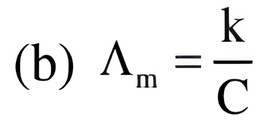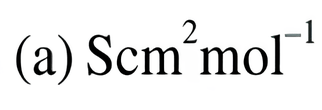Molar conductivity of solution is the conductance of solution containing one mole of electrolyte, kept between two electrodes having unit length between them and large cross-sectional area, so as to contain the electrolyte. In other words, molar conductivity is the conductance of the electrolytic solution kept between the electrodes of a conductivity cell at unit distance but having area of cross-section large enough to accommodate sufficient volume of solution that contains one mole of the electrolyte. It is denoted by λm.
Choose the most appropriate answer:

(iii) Solutions of two electrolytes ‘A’ and ‘B’ are diluted. The λm of ‘B’ increases 1.5 times while that of A increases 25 times. Which of the two is a strong electrolyte?
(a) electrolyte A
(b) electrolyte B
(c) electrolyte A & B
(d) None of these
(iv) Molar conductivity of ionic solution depends on ___________.
(a) pressure
(b) distance between electrodes
(c) concentration of electrolytes in solution
(d) surface area of electrodes
(v) The cell constant of a conductivity cell _____________.
(a) changes with change of electrolyte.
(b) changes with change of concentration of electrolyte.
(c) changes with temperature of electrolyte.
(d) remains constant for a cell.
Choose the most appropriate answer:

(iii) Solutions of two electrolytes ‘A’ and ‘B’ are diluted. The λm of ‘B’ increases 1.5 times while that of A increases 25 times. Which of the two is a strong electrolyte?
(a) electrolyte A
(b) electrolyte B
(c) electrolyte A & B
(d) None of these
(iv) Molar conductivity of ionic solution depends on ___________.
(a) pressure
(b) distance between electrodes
(c) concentration of electrolytes in solution
(d) surface area of electrodes
(v) The cell constant of a conductivity cell _____________.
(a) changes with change of electrolyte.
(b) changes with change of concentration of electrolyte.
(c) changes with temperature of electrolyte.
(d) remains constant for a cell.
(i) 
(ii)
(iii) (b) electrolyte B
(iv) (c) concentration of electrolytes in solution
(v) (d) remains constant for a cell.

(ii)

(iii) (b) electrolyte B
(iv) (c) concentration of electrolytes in solution
(v) (d) remains constant for a cell.
Assertion : Λᵒ m for weak electrolytes shows a sharp increase when the electrolytic solution is diluted.
Reason : For weak electrolytes degree of dissociation increases with dilution of solution.
(A) Both assertion and reason are true and the reason is the correct explanation of assertion.
(B) Both assertion and reason are true and the reason is not the correct explanation of assertion.
(C) Assertion is true but the reason is false.
(D) Assertion is false but the reason is true.
The following curve is obtained when molar conductivity is plotted against the square root of concentration, c½ for two electrolytes A and B :
Assertion : Conductivity of all electrolytes decreases on dilution.
Reason : On dilution number of ions per unit volume decreases.
(A) Both assertion and reason are true and the reason is the correct explanation of assertion.
(B) Both assertion and reason are true and the reason is not the correct explanation of assertion.
(C) Assertion is true but the reason is false.
(D) Assertion is false but the reason is true.
(i) Following reactions occur at cathode during the electrolysis of aqueous silver chloride solution :
= +0.80 V
= 0.00 V
On the basis of their standard reduction electrode potential (E°) values, which reaction is feasible at the cathode and why ?
(ii) Define limiting molar conductivity. Why conductivity of an electrolyte solution decreases with the decrease in concentration ?
Assertion: \(E_o\) cell should have a positive value for the cell to function.
Reason: \(E_{cathode}\) < \(E_{anode}\).
(A) Both assertion and reason are true and the reason is the correct explanation of assertion.
(B) Both assertion and reason are true and the reason is not the correct explanation of assertion.
(C) Assertion is true but the reason is false.
(D) Assertion is false but the reason is true.
When a certain conductance cell was filled with 0.1 M KCl, it has a resistance of 85 ohm at 25°C. When the same cell was filled with an aqueous solution of 0.052 M unknown electrolyte, the resistance was 96 ohms. Calculate the molar conductance of the electrolyte at this concentration.
[Specific conductance of 0.1 M KCl = 1.29 × 10⁻² ohm⁻¹ cm⁻¹]
In a galvanic cell, the following cell reactions occurs:
E°cell = +1.56 V
(i) Is the direction of flow of electrons from zinc to silver or silver to zinc?
(ii) How will concentration of Zn²⁺ ions and Ag⁺ ions be affected when the cell functions?
Molar conductivity of solution is the conductance of solution containing one mole of electrolyte, kept between two electrodes having unit length between them and large cross-sectional area, so as to contain the electrolyte. In other words, molar conductivity is the conductance of the electrolytic solution kept between the electrodes of a conductivity cell at unit distance but having area of cross-section large enough to accommodate sufficient volume of solution that contains one mole of the electrolyte. It is denoted by λm.
Choose the most appropriate answer:
Read the passage given below and answer the following questions:
Standard electrode potentials are used for various processes:
(i) It is used to measure relative strengths of various oxidants and reductants.
(ii) It is used to calculate standard cell potential.
(iii) It is used to predict possible reactions.
A set of half-reactions (in acidic medium) along with their standard reduction potential, E° (in volt) values are given below –
